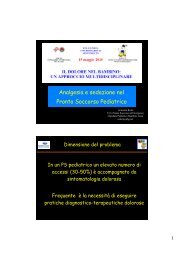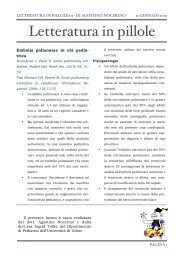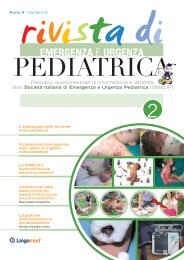scarica la rivista in PDF - SIMEUP
scarica la rivista in PDF - SIMEUP
scarica la rivista in PDF - SIMEUP
You also want an ePaper? Increase the reach of your titles
YUMPU automatically turns print PDFs into web optimized ePapers that Google loves.
La diagnostica per immag<strong>in</strong>i nell’urgenza toracica <strong>in</strong> età pediatrica<br />
Tabel<strong>la</strong> 15<br />
Contusione polmonare<br />
Risultato del danno alveolo-capil<strong>la</strong>re con edema ed emorragia negli alveoli e nell’<strong>in</strong>terstizio<br />
Fattore prognostico negativo (mortalità 10,8%)<br />
Rx torace: lesione non identificata nel<strong>la</strong> metà dei casi (45%) e sottostimata nel 25%<br />
Tac: opacità confluenti, noduliformi; prevalentemente posteriore; distribuzione non segmentaria; opacità semilunari<br />
periferiche (crescentic shape); l<strong>in</strong>ea trasparente sub-pleurica (subpleural spar<strong>in</strong>g)<br />
stimate. Generalmente, appaiono come opacità parenchimali<br />
disomogenee, a marg<strong>in</strong>i non ben def<strong>in</strong>iti,<br />
a distribuzione non segmentaria (Figure 15, 16A<br />
e 16B), che tendono a ridursi di volume, nei controlli<br />
nel tempo, <strong>in</strong> senso centripeto; a seconda del<strong>la</strong><br />
estensione e gravità, possono associarsi fratture<br />
costali e/o pneuomotorace, emotorace.<br />
Figura 15.<br />
Tenue addensamento medio toracico a dx sospetto per contusione polmonare.<br />
16A 16B<br />
Figure 16A e 16B.<br />
Contusione polmonare: multiple lesioni nodu<strong>la</strong>ri rotondeggianti di densità e volume variabili su tutto l’ambito polmonare.<br />
22 | <strong>rivista</strong> di EMERGENZA E URGENZA PEDIATRICA<br />
Al<strong>la</strong> Tac le lesioni contusive appaiono come opacità<br />
nodu<strong>la</strong>ri irrego<strong>la</strong>ri più o meno confluenti, a distribuzione<br />
prevalentemente posteriore, talora semilunari<br />
(crescent sign), ben dist<strong>in</strong>te dal<strong>la</strong> pleura<br />
da una banda iperetrasparente (subpleural spar<strong>in</strong>g)<br />
(Figura 17); nel 95% dei casi, quest’ultimo segno è<br />
predittivo di contusione.<br />
Figura 17.<br />
Contusione polmonare: “subpleural spar<strong>in</strong>g”.<br />
ANNO 2 - numero 0 | giugno 2008





